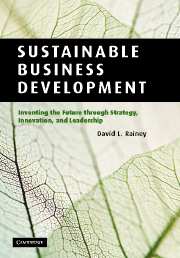Book contents
- Frontmatter
- Contents
- List of figures
- List of tables
- List of boxes
- List of abbreviations
- Acknowledgments
- Introduction
- Part I Enterprise thinking, the driving forces of change, and leadership
- Part II Innovation management, life cycle considerations, and insights
- 7 Sustainable technology management and development
- 8 Crafting and implementing sustainable business development programs
- 9 Life cycle thinking and framework
- 10 Formulation of life cycle assessment: initiation and inventory assessment
- 11 Implementation of life cycle assessment: impact and improvement assessments
- 12 Inventing the future through enterprise thinking and sustainable business development
- Glossary
- Select bibliography
- Index
- References
12 - Inventing the future through enterprise thinking and sustainable business development
from Part II - Innovation management, life cycle considerations, and insights
Published online by Cambridge University Press: 04 December 2009
- Frontmatter
- Contents
- List of figures
- List of tables
- List of boxes
- List of abbreviations
- Acknowledgments
- Introduction
- Part I Enterprise thinking, the driving forces of change, and leadership
- Part II Innovation management, life cycle considerations, and insights
- 7 Sustainable technology management and development
- 8 Crafting and implementing sustainable business development programs
- 9 Life cycle thinking and framework
- 10 Formulation of life cycle assessment: initiation and inventory assessment
- 11 Implementation of life cycle assessment: impact and improvement assessments
- 12 Inventing the future through enterprise thinking and sustainable business development
- Glossary
- Select bibliography
- Index
- References
Summary
Introduction
SBD and enterprise thinking provide the means for creating innovative solutions to social, economic, environmental, and business challenges. SBD invites corporations to create a better future through improved and enduring outcomes.
Business opportunities and challenges in the twenty-first century are expanding dramatically as the global business environment becomes more complex and dynamic. Large corporations have become global enterprises with sophisticated technologies, products, and services that depend on resources from far-flung suppliers, distributors, partners, and allies. Customers expect and demand innovative, high-quality and cost effective products and services. Forces such as globalization, technological change, increasing stakeholder power, the rapid transfer of information, knowledge, and technology, the outsourcing of operations, and increasingly intense market expectations and competitive responses define the new global business environment. In addition, the transformation to a digital world, shrinking product life cycles, fusion of technologies, customization of expectations, increased importance of partnerships and relationships, and proliferation of information place corporations in a new and unprecedented context, requiring innovative management constructs for achieving extraordinary results and sustainable success.
Corporations responded over the twentieth century by expanding the basis for decisions, making it more inclusive and more open to external participation. Listening to external constituents and understanding their requirements are the critical mechanisms for having a comprehensive perspective for determining strategic direction. By responding to a broader slice of the real world, corporations can discover new opportunities.
Information
- Type
- Chapter
- Information
- Sustainable Business DevelopmentInventing the Future Through Strategy, Innovation, and Leadership, pp. 647 - 689Publisher: Cambridge University PressPrint publication year: 2006
References
Accessibility standard: Unknown
Why this information is here
This section outlines the accessibility features of this content - including support for screen readers, full keyboard navigation and high-contrast display options. This may not be relevant for you.Accessibility Information
- 3
- Cited by
